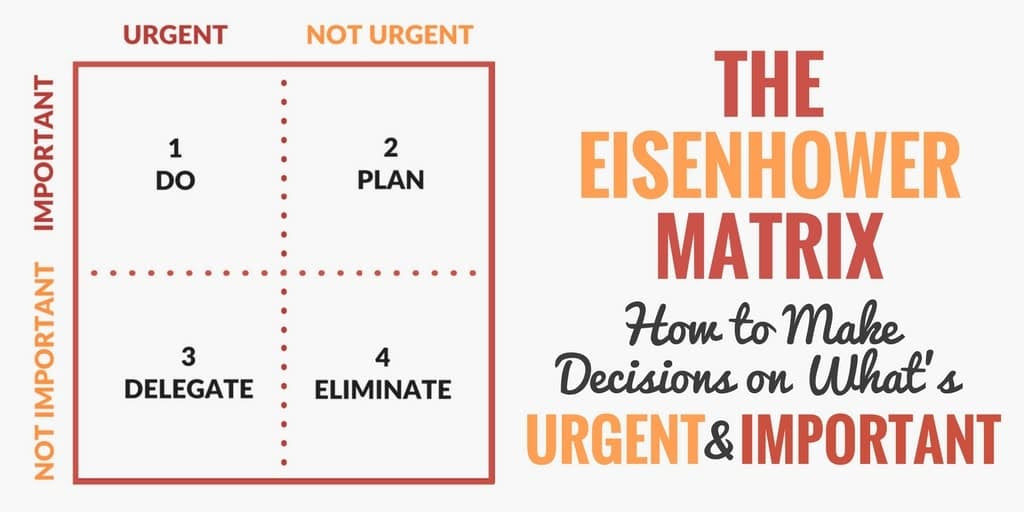Time Management Part 3: How to Finally Find the Time to Get It All Done!
So you’ve probably seen the diagram below on time management — like dozens of times! But the question is — are you using it (and getting more money or time)? And more importantly — do you know how to use it?

I find that for most of my clients, the answer is no. My guess is that you aren’t much different. Tasks pile up one on top of another. Effective time management seems like a pipe dream. Task lists are a mile long. And you finish each day feeling like there just isn’t enough time to get more money or stay on top of anything.
So when it comes to daily or weekly planning, prioritizing and figuring out what is next — you try to do it diligently — and sometimes you do, and sometimes you don’t.
But at the end of the day, you still feel overwhelmed, overloaded and wondering if you are doing the right things.
So what’s a smart entrepreneurial guy or gal to do?
Well, first, don’t forget to read parts 1 and 2 of this series:
Time Management Part 1: The 3 Ways You Are Managing Your Time Wrong (and how to fix it)
Time Management Part 2: 4 FoolProof Ways to Banish Burnout and Prevent Ball-Dropping
In part 3 — we are actually going to jump into a practical guide to using this matrix — so you can officially become a badass time management machine. (OK, too far? How about just happy with what you got done today?)
Let’s start with an explanation of each square:
1. Do — the urgent and important category. Here’s what usually falls into this category:
- Handouts for classes happening next week
- Creating content for talks, podcasts, interviews that are happening in the next week
- Creating newsletters, videos and social media that need to be posted immediately
- Handling preparation for immediate meetings
- Working on fulfillment for products or client projects that are due immediately
- Preparing for upcoming client meetings and events
- Getting anything done that is on a deadline
Most of us don’t struggle to finish the tasks in this category. We’ll stay up late, wake up early, do whatever it takes to get these tasks done. Some of us could work on not doing everything at the last minute, but we know deep down inside that it will all get done.
The problem is that these tasks take up most of our time, if not all of our time. This leaves no space for category 2. This is why most entrepreneurs are not growing as fast as they would like.
2. Plan — the not urgent, but still important category. Here’s what usually falls into this category:
- Looking at the numbers for the month, quarter, etc.
- Planning for the week, month or quarter
- Getting ahead on webinars, email writing, or articles for the next month
- Writing reports, gifts, emails, books — anything that will be launched later
- Inviting partners to participate in launches or support you in other endeavors
- Getting speaking events and sponsorships for the next quarter or next few months
- Creating processes for all crucial elements of your business
- Training and hiring the right team members
- Creating project plans and making decisions for what is happening in the business 6 months from now
- Taking time out to learn new skills that will come into play in future plans
- Doing sales conversations (many will put this off until the bank account runs empty)
- Working out, eating well and self care (many will put this off until they feel sick or the doctor puts them on a medication)
The wonderful thing about this category is that every item on the list is about future growth. Planning, business development, learning new skills, sales conversations, and self care are all critical to consistent and sustainable growth. But they don’t fall into the immediate category. So most business owners find themselves procrastinating on them until the bank account runs low or until the clients start to dry up.
And the truth is — how the heck are we supposed to find time to do this stuff? I mean if your every day is filled to the brim with immediate tasks from category 1 — what are you supposed to do?
Crunch Periods:
Well, the first step is understanding that you may be in a crunch period. A crunch period is when you’ve got too much on your plate from category 1, but you don’t have the team or staff to delegate to. So you as a business owner have turned into a full on WORKER in your business. And there’s no time to do anything that isn’t urgent, like visioning, planning and learning what it takes to move your business to the next level.
If you are in a crunch period — I have bad news and good news. The bad news is that you are going to have to give up some of your free time to get these important tasks done. Perhaps in the mornings, evenings or on the weekends. The good news is that if you focus on doing tasks like creating processes, hiring the right team members and doing sales conversations — you’ll be able to generate the revenue and team to eventually get your time back. But it may take 6-12 months to get there.
Every time my business has gone through a growth period, I have gone through a crunch period when it comes to time management. Suddenly there’s more tasks and management on my plate than I can fit into my “desired” normal hours of 10-6 each weekday. And I’ve gone through those crunch periods by adding in morning and weekend time.
But the good news is that I’ve managed to grow the company enough to hire new people, create processes and train others to take on more of my tasks. So it didn’t last forever.
The key thing to remember is that, without the tasks in category 2 — your business simply will not grow — or if it does it will be completely dependent on you (say goodbye to vacations).
So you must make time to get those category 2 tasks in somewhere — just for the short term.
3. Delegate — the urgent but not important tasks. Here’s what usually falls in this category:
- Formatting and editing documents and videos
- Sending out emails and finding great photos
- Handling client and meeting logistics
- Going through emails
- Calendar management
- Client communication and updates
- Updating and creating processes
- Handling billing and bookkeeping
- So much more…anything that YOU don’t need to be doing!
The most important thing to remember about this category is that there’s always multiple parts to every task. Try to look at what parts can be delegated and what parts need to be done by you. For example, running a meeting. You can create the agenda and think about content. But your team can set the room, make the content beautiful, buy the snacks, send out the reminder emails and so much more…
Your job is to be always asking the question, Who else can I get to do this?
4. Eliminate — not urgent and not important.
Rather than create a list here — because this will be different for each of you — I just want you to really consider this one as you go through your to-do list. Ask yourself, “Do I really need to do this? Or am I just being a perfectionist by keeping this task on the list?”
The key here is to be ruthless about asking the question, “Is this urgent? Is this important?” And if the answer is No, to just let it go.
How do you know if it is important?
Now a question I often get is — how do I know if something is important? The full answer to this is next week’s article — so stay tuned. But the short answer is: ask yourself if it is connected to reaching one of your 3 quarterly goals. Each quarter you want to have 3 goals — one or two revenue goals and one project goal. I’ll be writing more about quarterly goals next week…so don’t forget to come back!
In the meantime — look at that to-do list and start categorizing into the 4 categories. Also really notice which category the things are in that don’t get done.
Don’t forget — you will never get it all done! The key is making sure you make time for what is in categories 1 and 2.
My wish for you is to use your time well, make lots of money, and make this world a better place!
Photo: flickr, harpsicello








